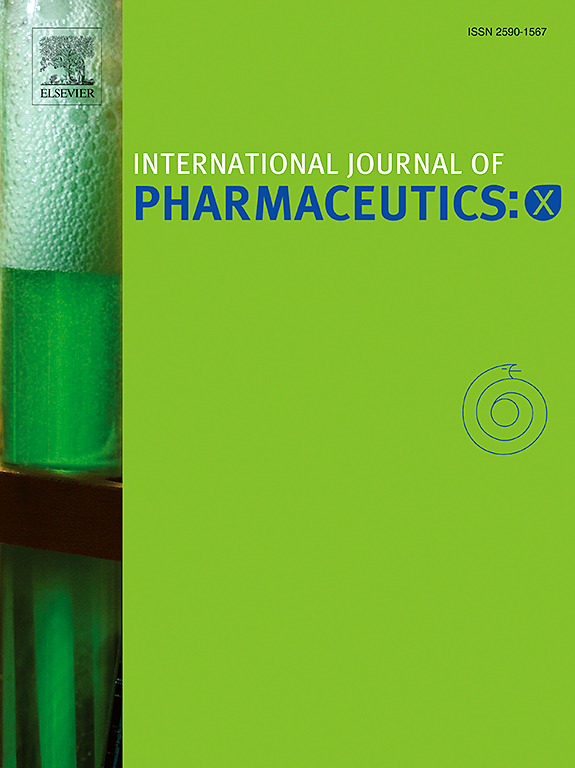Development of long-acting riluzole transdermal patch against amyotrophic lateral sclerosis: Mechanistic insights into polyglyceryl-3 dioleate-enhanced drug release and skin permeation
IF 6.4
2区 医学
Q1 PHARMACOLOGY & PHARMACY
引用次数: 0
Abstract
Patients with amyotrophic lateral sclerosis (ALS) often experience difficulty swallowing, making oral administration unsuitable for effective treatment. A transdermal drug delivery system (TDDS) offers a long-acting, non-invasive alternative for ALS therapy. In this study, a riluzole transdermal patch capable of sustained release over 72 h was developed. In vitro skin permeation and pharmacokinetic experiments were conducted to evaluate the impact of various factors—including drug loading, type and concentration of chemical penetration enhancers (CPEs), and type of pressure-sensitive adhesive—on riluzole absorption through the skin. The optimized patch formulation contained 17 % (w/w) riluzole and 10 % (w/w) polyglyceryl-3 dioleate (PGD), with an adhesive layer thickness of 111 μm. The final prescription penetration rate of riluzole was found to be 2.96 μg/(h·cm2). Optimized formulation displayed enhanced stability and prolonged pharmacokinetic performance (Cmax = 74.34 ± 13.62 ng/mL, MRT0-t = 34.91 ± 11.31 h). No significant skin irritation was observed. The role of PGD in the in vitro release and in vivo transdermal absorption of riluzole was thoroughly investigated. The results revealed that PGD not only reduced the interaction between riluzole and the pressure-sensitive adhesive, enhancing drug release but also increased the fluidity of skin lipids, leading to improved transdermal absorption. This study provides a comprehensive molecular-level understanding of PGD's effect on riluzole permeation, offering valuable insights for the rational selection of CPEs in the development of riluzole TDDS.

抗肌萎缩性侧索硬化症长效利鲁唑透皮贴剂的开发:聚甘油-3二油酸酯增强药物释放和皮肤渗透的机理
肌萎缩性侧索硬化症(ALS)患者经常经历吞咽困难,使口服给药不适合有效治疗。透皮给药系统(TDDS)为ALS治疗提供了一种长效、无创的替代方案。在这项研究中,利鲁唑透皮贴剂能够持续释放超过72小时。通过体外皮肤渗透和药代动力学实验,评价药物负荷、化学渗透促进剂(cpe)的类型和浓度、压敏胶粘剂的类型等因素对利鲁唑皮肤吸收的影响。优化后的贴片配方含有17% (w/w)的利鲁唑和10% (w/w)的聚甘油-3二油酸酯(PGD),粘接层厚度为111 μm。利鲁唑最终处方渗透率为2.96 μg/(h·cm2)。优化后的配方稳定性较好,药代动力学性能延长(Cmax = 74.34±13.62 ng/mL, MRT0-t = 34.91±11.31 h)。未观察到明显的皮肤刺激。研究了PGD在利鲁唑体外释放和体内透皮吸收中的作用。结果表明,PGD不仅降低了利鲁唑与压敏胶粘剂的相互作用,促进了药物释放,而且增加了皮肤脂质的流动性,从而改善了透皮吸收。本研究在分子水平上全面了解PGD对利鲁唑渗透的影响,为利鲁唑TDDS开发过程中cpe的合理选择提供有价值的见解。
本文章由计算机程序翻译,如有差异,请以英文原文为准。
求助全文
约1分钟内获得全文
求助全文
来源期刊

International Journal of Pharmaceutics: X
Pharmacology, Toxicology and Pharmaceutics-Pharmaceutical Science
CiteScore
6.60
自引率
0.00%
发文量
32
审稿时长
24 days
期刊介绍:
International Journal of Pharmaceutics: X offers authors with high-quality research who want to publish in a gold open access journal the opportunity to make their work immediately, permanently, and freely accessible.
International Journal of Pharmaceutics: X authors will pay an article publishing charge (APC), have a choice of license options, and retain copyright. Please check the APC here. The journal is indexed in SCOPUS, PUBMED, PMC and DOAJ.
The International Journal of Pharmaceutics is the second most cited journal in the "Pharmacy & Pharmacology" category out of 358 journals, being the true home for pharmaceutical scientists concerned with the physical, chemical and biological properties of devices and delivery systems for drugs, vaccines and biologicals, including their design, manufacture and evaluation. This includes evaluation of the properties of drugs, excipients such as surfactants and polymers and novel materials. The journal has special sections on pharmaceutical nanotechnology and personalized medicines, and publishes research papers, reviews, commentaries and letters to the editor as well as special issues.
 求助内容:
求助内容: 应助结果提醒方式:
应助结果提醒方式:


